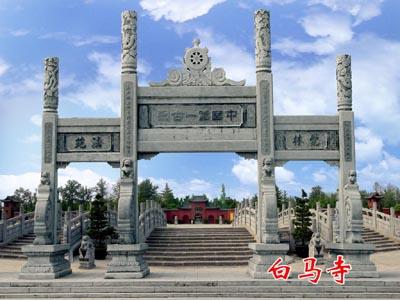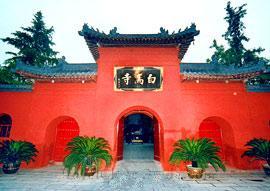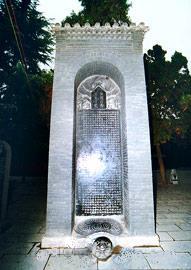
History of Luoyang: one of the seven ancient capital cities in China's history, served sooner or later as the capital city with a history of 1592 years and for 13 different dynasties (the Xia, the Shang, the Eastern Zhou, the Eastern Han, the Cao Wei, the Western Jin, the Northern Wei, the Sui and the Tang, etc.); considered the miniature of the ancient Chinese history.
White Horse Temple (Baima Temple) is located 12 km away from Luoyang City. Established by the Han Dynasty in 68 AD when Buddhism started to spread, this temple is believe to be the first Buddhist temple built by the government in China.

According to historical records, Emperor Ming of the Eastern Han Dynasty (25 - 220 AD) once sent his minister on a diplomatic mission to western region to learn about Buddhism. After finished study, they came back with two eminent Indian dignitary monks - She Moteng and Zhu Falan, and a white horse carried the sutra and the figure of Buddha. In order to memorialize the white horse's contribution of taking back the sutra, Emperor Ming ordered the construction of the temple and named it White Horse Temple.
White Horse Temple was regarded as the "originating court" and the "cradle of Chinese Buddhism" by the Buddhist disciples. Since its establishment, White Horse Temple has experienced vicissitudes of centuries. It was rebuilt for several times, in which the restoration during the reign of Emperor Wu Zetian was especially notable in its large scale.
Today's White Horse Temple is a rectangle courtyard facing south. The gate of the White Horse Temple was built in Ming Dynasty (1368 - 1644) and it is three arches side by side. Covering a total area of 40, 000 square meters, the temple mainly consists of Tianwang Hall, Great Buddha Hall, Daxiong Hall, Jieyin Hall, Qingliang Terrace and Pilu Pavilion, which are all distributing along the north-south central axis.
Tianwang Hall (Heavenly King Hall)
Standing behind the temple gate, Tianwang Hall is the first hall of this temple. In it, the Maitreya Buddha was enshrined with four Heavenly Kings on both sides. The four Heavenly Kings hold respectively a pipa, a sward, a snake and an umbrella in their hand, which symbolizing favorable weather for crops and a prosperous and peaceful country for the people. Behind the Maitreya Buddha is Weituo, the protector of the Buddhist doctrine.
Great Buddha Hall
Great Buddha Hall is the second hall of the temple. It is the place where the grand Buddhist ceremonies are held. The existent hall dates from the Ming Dynasty (1368 - 1644). In its center sits erect a statue of Sakyamuni which is closely flanked by two Bodhisattvas Wenshu and Puxian, and his two disciples Ananda and Jiaye. Behind stand the statue of Avalokitesvara.
In the southeast of the hall, a huge bell is hung from the beam. It was said that when the bell is struck, the toll could be heard far away. More interesting is that once the bell is tolling, the one in Bell Tower in Luoyang Old Town will response it quickly due to the sympathetic vibration. "Horse Temple Bell", one of the eight scenes in Luoyang city was named from it.
Daxiong Hall (Great Hero Treasure Hall)
Originally built in the Yuan Dynasty (1271- 1368) and rebuilt in the Ming and Qing dynasties, Daxiong Hall was the most magnificent in scale and most splendid in view. The hall houses three Buddhas. Sakyamuni is sitting in the center with Medicine Buddha who from the Eastern Pure Land of Azure Radiance on the left and Amitabha Buddha, the teacher of the Western Pure Land on the right.
The hall also house eighteen Arhats. They are vivid in modeling and unique in gesture and are treasures in Buddhist arts of the Yuan Dynasty.
Qingliang Terrace
The fourth hall is Jieyin Hall (Receiving and Directing to Paradise Hall). Behind it is a platform named Qingliang Terrace. Rebuilt in the Ming Dynasty, Qingliang Terrace was said to be the place where Emperor Ming of the Han Dynasty read and rest. Later, the two dignitary monks from Indian once lived here and preached Buddhism and translated scripture books until death. After the Eastern Han Dynasty, this terrace was adopted to house the Buddhist sutra.
Qiyun Pagoda (Cloud Reaching Pagoda)
Located about 200 meters southeast of White Horse Temple is Qiyun Tower. It was originally built in the Later Tang Dynasty during the Five Dynasties as a pavilion-like wooden structure. Later, destroyed in a fire, it was rebuilt in 1175 as a 13-story square brick structure with closely arranged eaves.

Qiyun Pagoda is 25 meter in height with 13 stories and 7.8 meters on each side at the bottom. Displaying a unique style, the pagoda belongs to the style of cubic shaped, close eaves brick pagoda. The eaves are built with small, exquisite overlapping bricks. Once you clap your hands 20 meters away from the pagoda, the echo reflected from the eaves sounds like frogs croaking.
Qiyun Pagoda is also one of the few ancient buildings of the Jin Dynasty (1115 - 1234) in central China.
Besides, White Horse Temple has kept more than 40 upright stone tablets through the ages since the Tang Dynasty. Among them the Notes of Luojing Baima Temple Originating Court handwritten by Zhao Mengfu, a famous calligrapher of the Yuan Dynasty, is the most precious one.
Outside of the temple there is two stone horses, all in life-size. These two horses look geniality and tractability. They are the stone-carved horses made in Song Dynasty (960 - 1279), and they are the excellent artwork.
| 


